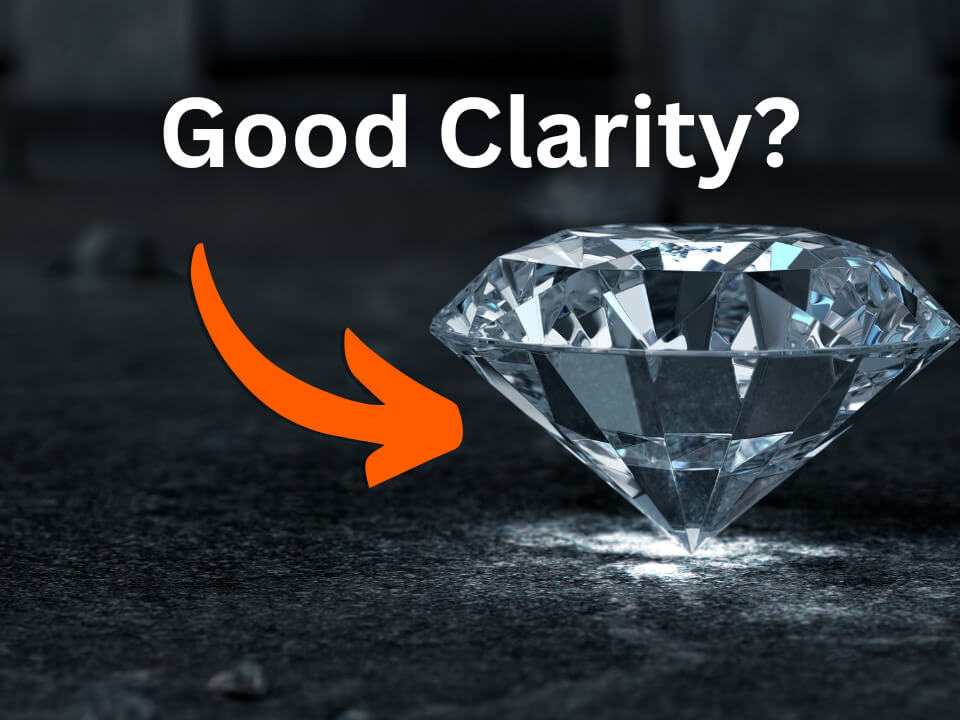Just the way you would check the Blue Book value before buying a car, or online ratings of restaurants before booking a reservation, you can compare the value and quality of diamonds based on their clarity – something that’s important to understand if you’re about to embark on the process of buying the perfect engagement ring and making sure you get the best bang for your buck

Understanding the 4 C’s – Overview
The grade of a diamond is made up of the 4 C’s: color, cut, carat weight, and clarity. Each C has its own grading scale that evaluates the stone’s quality. When the 4 C’s are put together, it helps diamond sellers determine the price and compare stones to one another. But, understanding these elements is a useful tool for you, too. The more you understand, the savvier you can be about choosing the perfect diamond for your bride-to-be, and your pocket.
What is Diamond Clarity?
Diamond clarity is a metric used to grade the visual appearance of internal characteristics of a diamond. The fewer blemishes and inclusions, the better the clarity. While clarity can influence the value of a stone, most imperfections can not be recognized with the naked eye.
Natural diamonds form within the earth’s mantle layer at depths ranging from 80 – 120 miles. The stones face extreme heat up to as much as 2,200 degrees Fahrenheit. While diamonds take between a billion to three billion years to grow, only the rarest will emerge in perfect condition. Most of the time, diamonds are imperfect with varying amounts of surface blemishes and internal inclusions.
The GIA diamond clarity scale goes from Flawless (FL) all the way to Included 3 (I3). It’s worth noting that clarity doesn’t particularly matter for Very Slightly Included 2 (VS2) and above because these inclusions cannot be seen by the naked eye.

Inclusions can be a good thing – especially when you want to stick to your budget. The presence of inclusions makes diamonds more reasonably priced than the rarer and costlier Flawless (FL) or Internally Flawless (IF) stones.
Does Diamond Clarity Affect Sparkle?
The level of clarity in a stone tells you how many external and internal flaws the diamond has, and how big, and visible they are. Overall, clarity has no considerable impact on the sparkle and is seldom noticeable to the naked eye.
Aside from saving money, there are benefits to having inclusions in diamonds. Inclusions are kind of like fingerprints. They make each stone unique, and since no two diamonds are alike in terms of inclusions, this can help you identify your stone if you ever leave it at a jeweler for repairs or cleaning. Think of inclusions as the one-of-a-kind markings that make the diamond just as one-of-a-kind as your soon to be fiancée.
Remember: it is difficult to spot inclusions with the naked eye. For instance, if you look at a VS2 diamond and personally cannot see inclusions without magnification, you can save on the cost of the diamond without having to compromise on beauty and serious bling. When buying your diamond online, most jewelers offers full refunds and free returns or exchanges should you not be pleased with your purchase.
What Is the Best Clarity of a Diamond on a Budget?
While the appeal of the diamond for your significant other’s engagement ring is going to boil down to preference and personal choice, it can be tough trying to figure out which clarity grade is the “best.” The important thing is to understand how clarity impacts the beauty of a stone.
For instance, a stone that is flawless might well offer the best grade of clarity, but that doesn’t promise that the stone will actually look sensational. A diamond with an SI1 or SI2 grade can look just as good as a diamond with a FL grade.
Some people choose to buy flawless diamonds for symbolic reasons, and that’s certainly their choice. But, the majority of guys buying engagement rings don’t have such requirements, and the best diamond clarity grade is going to be the one that offers you the most value for your money. Overall, diamonds that fall in the VS2 or SI1 clarity tend to offer the best value for your budget.
If you’re on a tight budget and you want to get the best stone you can afford for your fiancée-to-be, the best diamond clarity grade is VS2 or SI1. Most casual viewers can’t tell the difference between a VS2 or SI1 diamond, anyway, but it’s easier for them to notice the differences in diamond size. In general, it’s wiser to spend the money you save on a lower clarity and invest it in a diamond that sports a bigger carat and better color. Clarity is hard to notice if you’re not a diamond pro, so it just doesn’t make sense to pay top dollar for something that can’t be readily appreciated, let alone seen.
If you plan on buying a stone larger than 1.5 carats, the ideal clarity rating for the diamond is going to be VS1 or better. That’s because as stones go up in carat size, the inclusions become more apparent.
Bottom Line
In theory, inclusions could have a negative effect on the diamond’s sparkle, but they’d have to be pretty big inclusions to hamper light performance. Only diamonds graded I1 or below on the GIA clarity scale would fall into this category. In reality, though, inclusions are so tiny that they are powerless to stop the power of a sparkling diamond. It is down to the quality of the cut that actually gives a diamond its fire and brilliance, and clarity is the least important of the 4 C’s.
Diamonds that fall in the VS2 to SI1 range will give you the best value for your money. After all, flawless is your lady, not the stone on her finger!
